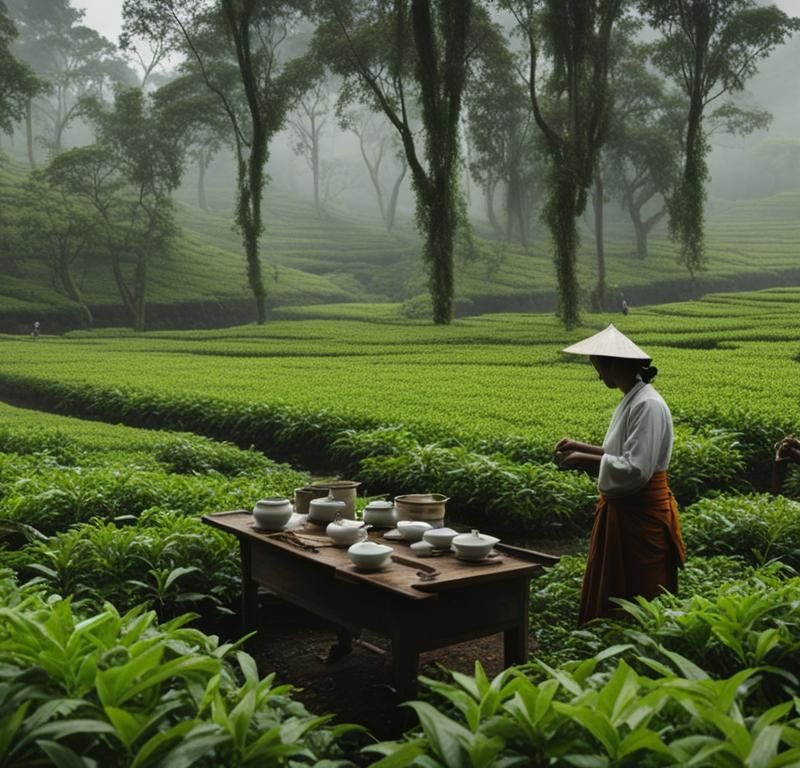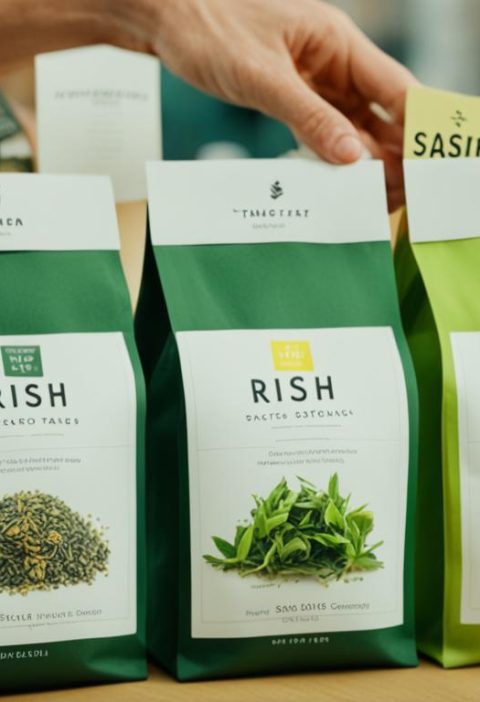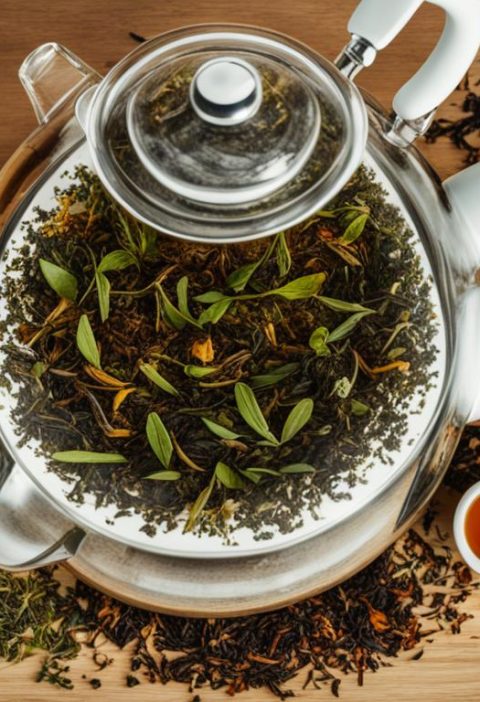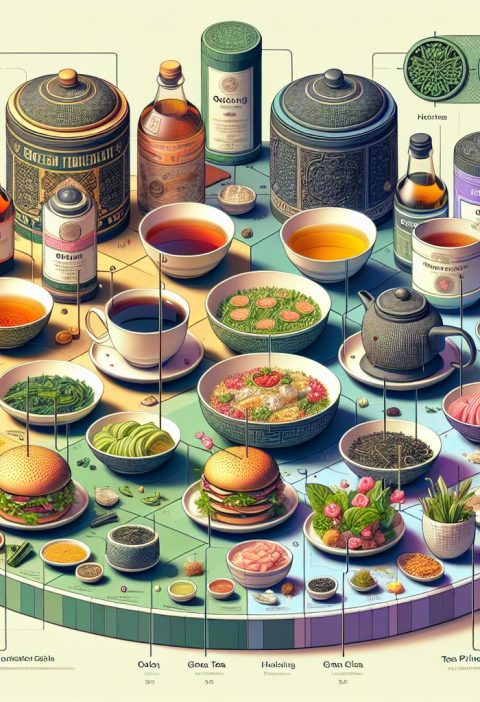White tea, with its gentle and delicate characteristics, offers tea enthusiasts a unique flavor journey that is worth embarking on. Derived from the same tea plant as green, black, and oolong teas, white tea undergoes minimal processing, preserving its natural qualities and resulting in a pale, straw-colored infusion with a subtly sweet taste. Not only is white tea known for its antioxidants, but it is also regarded as a healthy choice for individuals looking to reap the benefits of tea. With different varieties to explore and various brewing techniques to enhance its flavors, delving into the nuances of white tea promises a delightful and gratifying experience.
Key Takeaways:
- White tea is a gentle and delicate variety derived from the same tea plant as green, black, and oolong teas.
- It undergoes minimal processing, preserving its natural qualities and resulting in a subtly sweet taste.
- White tea is known for its antioxidants and is considered a healthy choice for tea enthusiasts.
- There are different varieties of white tea, each with its own unique flavor profile.
- Exploring white tea involves discovering various brewing methods to enhance its nuances.
The Origins and Development of White Tea
White tea has a rich and fascinating history that dates back to ancient China. Let’s delve into the origins and development of this exquisite beverage.
During the Tang Dynasty in China’s Fujian province, white tea first emerged. It was crafted from the tender buds and young leaves of the tea plant, and primarily used for its medicinal properties. The unique production process involved minimal oxidation, allowing white tea to retain its natural qualities and delicate flavor.
The Song Dynasty brought a surge in white tea’s popularity, as it became a cherished “tribute tea” enjoyed by the emperor and nobility. This elevated its status, making it a symbol of refinement and luxury.
As time went on, different varieties of white tea began to emerge. The Ming Dynasty saw the introduction of Silver Needle and White Peony, two of the most renowned and prized white teas. These teas were distinguished by their distinct flavors and appearances, further cementing white tea’s position in Chinese tea culture.
The Qing Dynasty marked a significant milestone in the development of white tea. Sun-drying techniques were introduced, revolutionizing the tea production process and enhancing the flavors of white tea leaves. This innovation led to the creation of even more refined and aromatic white teas.
In the 19th century, white tea transcended China’s borders and gained recognition worldwide. It found its way to European tea markets and sparked curiosity among tea connoisseurs. However, its popularity waned over time, overshadowed by the rise of black and green teas.
Fortunately, the 1980s witnessed a revival of interest in white tea. Tea enthusiasts rediscovered its unique flavor and health benefits, prompting a resurgence in production. This revival also brought forth innovations in white tea processing and the creation of flavored white teas, showcasing the versatility and creativity that white tea offers.
Through centuries of history and development, white tea has evolved into an exquisite and sought-after tea variety. Its delicate flavors, rich cultural heritage, and potential health benefits continue to captivate tea drinkers around the world.
Health Benefits of White Tea
White tea is a gift from nature, offering a range of health benefits that can enhance our overall well-being. One of the key factors that sets white tea apart is its high antioxidant content, particularly catechins. These powerful compounds combat oxidative stress, protect against free radicals, and promote cellular health.
Research suggests that regular consumption of white tea can have significant positive effects on our heart health. The antioxidants in white tea contribute to reducing the risk of heart diseases by improving blood flow, reducing inflammation, and lowering blood pressure.
Additionally, white tea may play a role in weight management due to its ability to boost metabolism. Drinking white tea can assist in burning fat and calories, making it an excellent choice for those aiming to maintain a healthy weight.
The high concentration of antioxidants in white tea contributes to its reputation as a healthful elixir. By incorporating white tea into our daily routines, we can experience these remarkable benefits for ourselves.
Heart Health and White Tea
- Reduces the risk of heart diseases
- Improves blood flow and circulation
- Lowers blood pressure
Weight Management and White Tea
- Boosts metabolism
- Promotes fat burning and calorie reduction
- Aids in maintaining a healthy weight
White Tea vs. Green and Black Tea
When it comes to white tea, a key distinction lies in its processing compared to green and black teas. White tea undergoes minimal processing, allowing it to retain a higher concentration of natural compounds. This minimal oxidation contributes to its delicate flavor profile and sets it apart from the bolder flavors of green and black tea.
White tea’s flavor is subtle and nuanced, with delicate floral and fruity notes. Its gentle taste and light body make it a refreshing choice for tea enthusiasts seeking a more delicate tea experience.
In terms of caffeine content, white tea falls between green and black tea. It generally contains less caffeine than black tea but slightly more than green tea. This makes it a balanced option for those who prefer a moderate caffeine intake.
Comparison: White Tea, Green Tea, Black Tea
| Tea Type | Processing | Flavor Profile | Caffeine Content |
|---|---|---|---|
| White Tea | Minimal processing | Delicate, nuanced | Generally less than black tea, slightly more than green tea |
| Green Tea | Steamed or pan-fried | Grassy, vegetal | Less than black tea, slightly less than white tea |
| Black Tea | Fully oxidized | Robust, bold | More than white tea, slightly more than green tea |
As seen in the comparison table above, each type of tea undergoes different processing methods, resulting in distinct flavors and caffeine contents. While white tea offers a delicate flavor profile with moderate caffeine, green tea leans towards grassy and vegetal notes with lower caffeine levels. On the other hand, black tea boasts a robust and bold taste complemented by a higher caffeine content.
Brewing White Tea
White tea can be brewed using different methods, each showcasing the delicate flavors and aromas unique to this gentle brew. Whether you prefer a simple cup brewing or the traditional gaiwan style, here are some tips to help you achieve the perfect white tea infusion.
Direct Cup Brewing
When brewing white tea directly in a cup, it’s essential to pay attention to water temperature and brewing time to avoid overpowering the delicate leaves. Follow these steps:
- Boil water and let it cool to the right temperature. For white tea, the recommended water temperature is between 71°C to 85°C (160°F to 185°F). This range allows the flavors to gently unfold without scorching the leaves.
- Place a white tea bag or loose leaves in your cup.
- Pour the hot water over the tea and let it steep for 2 to 3 minutes, allowing the flavors to infuse into the water.
- Adjust the brewing time based on your preference. Steeping for a shorter time will result in a lighter flavor, while a longer steeping time will produce a bolder infusion.
- Once brewed, remove the tea bag or strain the leaves to prevent over-extraction.
Remember, brewing time and water temperature are subjective, and you can experiment to find the perfect balance that suits your taste.
Traditional Gaiwan Style
The gaiwan, a traditional Chinese teapot, is often used to brew white tea. This method allows for multiple infusions while capturing the essence of the leaves. Here’s how to brew white tea using a gaiwan:
- Rinse the gaiwan with hot water to ensure cleanliness and warm up the teapot.
- Add about 4-5 grams of white tea leaves into the gaiwan.
- Slowly pour hot water (71°C to 85°C) into the gaiwan, covering the leaves.
- Allow the tea to infuse for approximately 20 seconds for the initial steep. This short steeping time helps extract the delicate flavors.
- Pour the infused tea into a separate cup, leaving the tea leaves inside the gaiwan.
- For subsequent infusions, increase the steeping time by around 10 seconds with each infusion to extract different layers of flavor.
- Continue the process for multiple infusions or until the flavors become too diluted.
The gaiwan brewing method allows you to appreciate the subtleties of white tea while exploring its evolving flavors with each subsequent infusion.
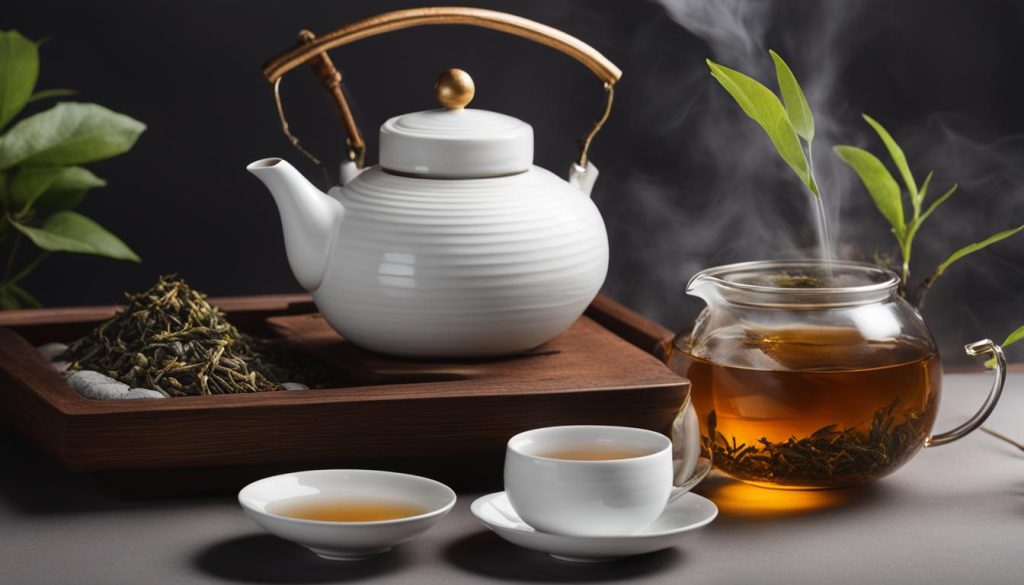
Selecting and Storing White Tea
When it comes to white tea, selecting the right quality is key to experiencing its ultimate flavor. We recommend starting with high-quality white tea to ensure a delightful and satisfying tea-drinking experience. Begin your journey by exploring premium white teas and trying different varieties to discover your personal preference.
Once you have chosen your favorite white tea, proper storage is essential to maintain its freshness and preserve its delicate flavors. Storing white tea in the right conditions will ensure that every cup you brew is a true reflection of its distinct nuances. For optimal storage, follow these guidelines:
- Use an airtight container: To prevent exposure to air and moisture, transfer your white tea to airtight containers. This will help retain its original taste and quality.
- Away from strong odors: White tea is highly susceptible to absorbing odors from its surroundings. Keep your white tea away from strong-smelling substances to preserve its natural aroma.
- Avoid humidity: Moisture can degrade the quality of white tea. Store it in a dry environment to maintain its crispness and flavor.
- Shield from direct sunlight: Sunlight can accelerate the deterioration of white tea. Store it in a cool, dark place to protect it from harmful UV rays.
By following these storage guidelines, you can enjoy the full potential of your white tea for an extended period. Ensure that each brewing session is a delightful experience, steeped in the goodness of high-quality white tea.
| Storage Tips | Benefits |
|---|---|
| Use an airtight container | Preserves freshness and flavor |
| Away from strong odors | Retains natural aroma |
| Avoid humidity | Maintains crispness |
| Shield from direct sunlight | Prevents UV-induced degradation |
The Caffeine Content in White Tea
When it comes to caffeine, white tea offers a gentler alternative to coffee while still providing a subtle pick-me-up. The caffeine content in white tea can vary depending on several factors, including the type of tea and brewing techniques used.
On average, a cup of white tea contains between 6 to 75 milligrams of caffeine. This range allows individuals to choose a white tea option that aligns with their caffeine tolerance and preferences. Compared to coffee, white tea generally has significantly less caffeine, making it a suitable choice for those seeking a milder boost in energy.
If you’re looking to further reduce the caffeine content in your white tea, there are several brewing techniques you can employ:
- Use water at cooler temperatures: Lowering the water temperature to around 71°C to 85°C (160°F to 185°F) can help minimize the extraction of caffeine from the tea leaves.
- Avoid long steeping times: Steeping white tea for shorter durations, typically 2 to 3 minutes, can result in a lighter infusion with reduced caffeine levels.
By adjusting these brewing techniques, you can tailor the caffeine content of your white tea to suit your individual preferences and caffeine sensitivity.
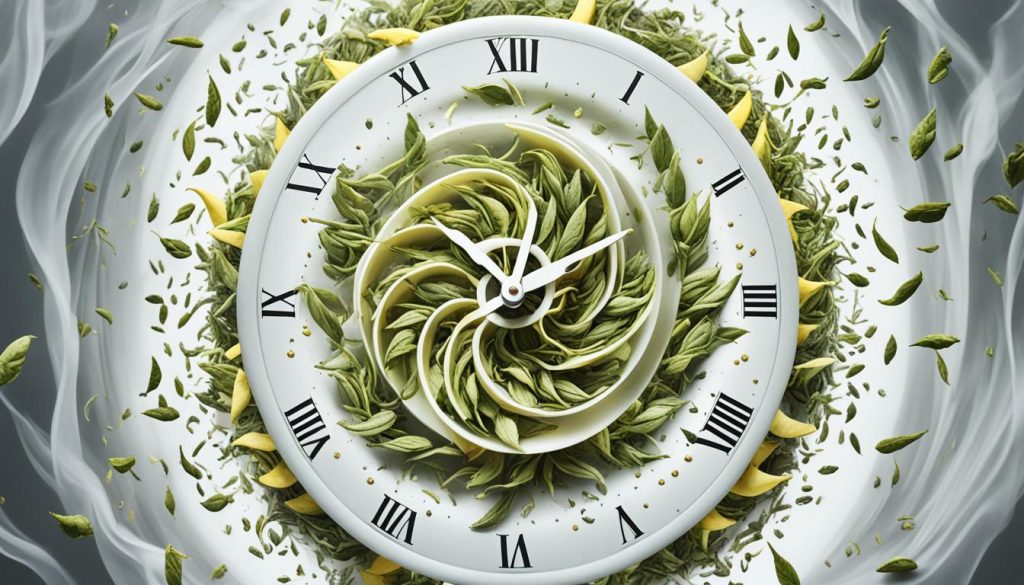
| Tea Type | Average Caffeine Content (per cup) |
|---|---|
| White Tea | 6-75 milligrams |
| Coffee | 95-165 milligrams |
Reviving the Popularity of White Tea
In the 1980s, white tea experienced a revival as tea enthusiasts rediscovered its unique flavor and health benefits. This renewed interest led to innovations in white tea production and processing. Flavored white teas became popular, blending white tea with fruits, flowers, and herbs to create unique flavors. White tea also gained recognition as a superfood due to its high concentration of antioxidants and potential health benefits.
During the revival, tea enthusiasts and experts alike began to rediscover the exquisite taste and delicate qualities of white tea. They recognized its potential as a healthier alternative to other beverages and embraced it for its potential health benefits. This newfound popularity sparked a wave of innovations in white tea production and processing methods.
One of the most significant innovations was the introduction of flavored white teas. By blending white tea leaves with fruits, flowers, and herbs, tea producers were able to create an array of unique and enticing flavors. These flavored white teas appealed to a wider audience and brought a fresh perspective to the world of tea.
Additionally, the revival of white tea brought attention to its high concentration of antioxidants. White tea was recognized as a superfood, known for its potential to boost the immune system, protect against free radicals, and promote overall well-being.
The revival of white tea opened up new opportunities for tea producers and consumers alike. It breathed new life into an ancient beverage, allowing it to reclaim its rightful place among the most cherished and sought-after teas in the world.
Conclusion
The world of white tea is a captivating journey that offers a multitude of nuances and flavors waiting to be explored. From its ancient origins in China to its revival in the modern era, white tea has evolved to cater to the diverse tastes and preferences of tea enthusiasts worldwide.
Whether you prefer the delicate and ethereal notes of Silver Needle or the bolder, more robust flavors of White Peony, each variety of white tea offers a unique experience for your palate. Exploring the world of white tea allows you to appreciate the subtle elegance and intricate flavors that make this brew truly special.
As you embark on your white tea journey, it is not only the flavors that captivate but also the healthful benefits that accompany this gentle elixir. White tea’s rich antioxidant content promotes overall well-being, making it an excellent choice for those seeking a health-conscious beverage.
So, join us in embracing the enchanting world of white tea. Take the time to appreciate each sip, as you deepen your understanding and appreciation for this prized brew. Allow the nuances of white tea to transport you on a sensory adventure, and discover the true essence of this remarkable tea.
